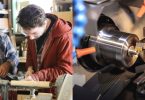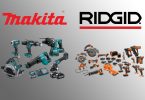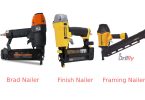A palm sander is a good choice for detailing jobs and sanding in tight spaces. But you will need an orbital sander for more aggressive material removal in larger areas.
However, if you want to increase material removal efficiency on different surfaces with a smooth finish then there isn’t any better choice than a random orbital sander.
Palm sanders
Palm sanders – also known as finish or quarter sheet sanders – are small, lightweight, and easy-to-control power tools commonly used for sanding woods, drywall, and other surfaces that require a smooth finish before painting or staining jobs.
They are called “palm” sanders because they are small enough to fit in the palm of your hand for easy maneuver and better control. They use circular sandpaper disks that attach to the sander’s base plate, which spins rapidly to sand down the surface.
Orbital sanders
Orbital sanders have larger pads (5-8 inches or more in diameter) than palm sanders because they are designed to remove materials more efficiently. These types of sanding tools are effective for rough surfaces, removing paint or varnish, or preparing surfaces for a new coat or finish.
Unlike palm sanders, they have a square or rectangular base plate that moves in a small circular motion, rather than a purely rotary motion. This orbital action helps reduce the likelihood of leaving swirl marks on the surface being sanded, making them a popular choice for finishing work.
There are two main types of orbital sanders –
- Quarter-sheet orbital sanders are smaller and more compact for smaller projects and tighter spaces
- Half-sheet orbital sanders are larger and more powerful that suit more heavy-duty sanding jobs
Random orbital sanders
When talking about orbital sander vs palm sander, random orbital sanders are also worth mentioning because they are the best of both worlds.
Random orbital sanders combine the circular motion of an orbital sander with the random linear motion of a finish sander, resulting in a sander that can remove material quickly and efficiently with a smooth, even finish.
They usually use velcro-backed sanding discs that can be easily swapped out as needed for different grits of sandpaper. One of their key benefits is that they can be used for both rough sanding and fine finishing work.
These versatile tools can be used on a variety of surfaces, from wood and metal to plastic and paint.
Orbital Sander vs Palm Sander vs Random Orbital Sander
| Features | Orbital | Random | Palm |
| Disc diameter | 5-6 inch or more | 5-6 inch or more | 1/4 sheet |
| Disc holes | 5-10 or more | 5-10 or more | 8-10 |
| Battery | Yes | Yes
(30-60 min backup) |
Yes |
| Engine power | 2-3 amps | 3-5 amps | 2-3 amps |
| Dust collector | Yes | Yes | Yes |
| Pad rotation | Circular | Random orbit | Oscillating |
| Finishing | Fine | Fine | Very fine |
| Weight | 2-4 lbs | 2-4 lbs | 2-4 lbs |
| Orbit per minute | 4,000-14,000 OPM | 5,000-12,000 OPM | 7,000-12,000 OPM |
| Durability | Depends on brand & model | Depends on brand & model | Depends on brand & model |
| Swirl marks or other visible patterns | More likely | Highly unlikely | Unlikely |
| Best suited for | Sanding flat areas | Sanding curves | Finish sanding |
| Price | $100-$250 | $150-$500 | $50-$150 |
Disc diameter
Palm sanders have the smallest sanding pads (1/4 sheet), while orbital and random orbital sand pads are larger (5-6 inches or more).
This impacts their performance on the surface area and the amount of material they can remove in a single pass.
Disc holes
The amount of disc holes in a sander affects its dust collection abilities and its overall efficiency and effectiveness.
Orbital sanders and random orbital sanders have the highest number of disc holes (5-10 or more), while palm sanders have 6 or 8 holes.
Battery
All three types of sanders are available in battery-powered versions that are more convenient in areas where there is no access to electrical outlets. When choosing a battery-powered sander, you should consider the battery life, charging time, and the convenience of being able to swap out batteries if needed.
Engine power
The engine power of a sander can affect how quickly and efficiently it can remove materials, as well as how long it can be used without overheating or wearing down. Random orbital sanders have the highest power (3-5 amps), while the orbitals and palms have (2-3 amps).
Dust collector
Random orbital sanders often come with an advanced dust collection system that includes a bag and a vacuum adapter, while orbital and palm sanders have a dust bag only. However, some new models now feature vacuum adapters as well.
Pad rotation
While a palm sander’s pad rotates with a linear motion, the orbital has a circular motion and the random combines both circular and random motions.
That makes the random orbital sander the most versatile option for a range of sanding tasks, while the palm sander is better suited for specific, detailing projects.
Finishing
Palm sanders are specifically designed for finishing jobs with a high level of precision and control while orbital sanders may leave visible swirl marks in some cases. As you already know, you won’t have to deal with swirl marks with a random orbital sander.
Convenience
Palm sanders are usually the easiest to use due to their lightweight and small size. This means you can use them for long hours without tiring your hands.
On the other hand, although both random orbital sanders and orbital sanders are a little heavier, they often have features like ergonomic handles and reduced vibrations to help improve comfort and control.
Orbit per minute
The orbit per minute (OPM) on a sander can affect the speed, efficiency, and level of control while sanding. Random orbital sanders have a higher OPM than palm or orbital sanders, which makes them an effective tool for sanding down large areas or removing materials quickly.
However, a higher OPM can also require more control and precision from the user’s end, so this may not be the best option for detailing jobs.
Durability
This mainly depends on the specific model and brand of the sander. Those from premium brands definitely last longer and serve better than the knockoffs and cheap units.
The most renowned brands in the industry are Bosch, Makita, Black+Decker, Chicago Pneumatic, DeWalt, Milwaukee, Ryobi, Metabo, Craftsman, Ridgid, and Porter-Cable.
Swirl marks
Random orbitals and palm sander is often the best option for avoiding visible swirl marks or other visible patterns on the surface but orbital sander may be more likely to leave swirl marks, depending on the specific model and type of sandpaper used.
Applications
A palm sander is best for detailing jobs or small projects where precision and control is key.
However, orbitals are suitable for quickly removing materials from large areas while random orbitals are the most versatile option, capable of handling a wide range of sanding tasks with efficiency and precision.
Cost
Palm sanders are the least expensive option, while orbital sanders are moderately priced and random orbital sanders are the most expensive. However, the specific cost of each sander can vary depending on the brand, model, and additional features included.
FAQs
1. Orbital sander vs random orbital sander: which one is better for woodwork?
Ans: You can use orbital sanders but they can leave swirl marks on the wood surface. If your priority is both sanding and effective finishing then you should use a random orbital sander.
2. If a random orbital sander is good for sanding and finishing, why do some people still use palm sanders?
Ans: Orbital sander pads are round in shape, which is not suitable for sanding tight spaces or edges. That’s why people use a palm sander for sanding tight spaces and corners since the little rectangle shape is suitable for sanding edges.








